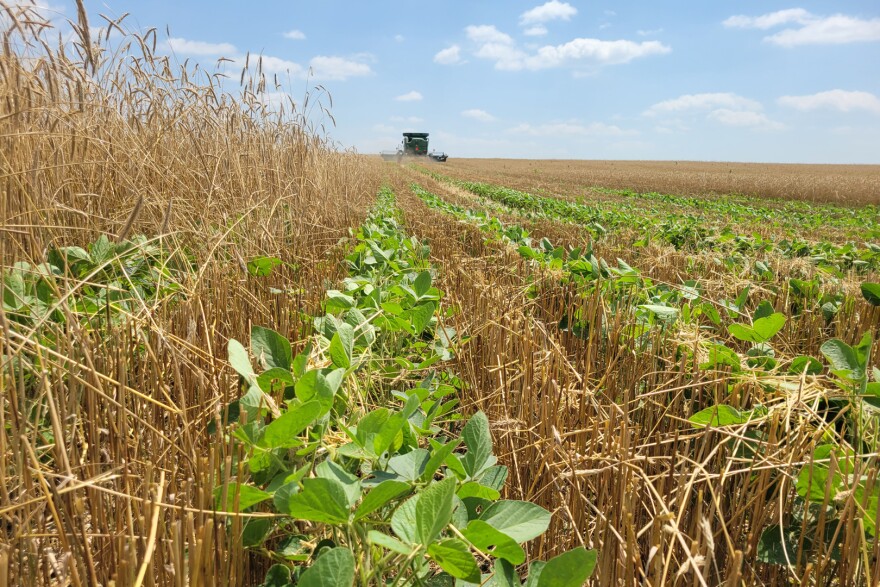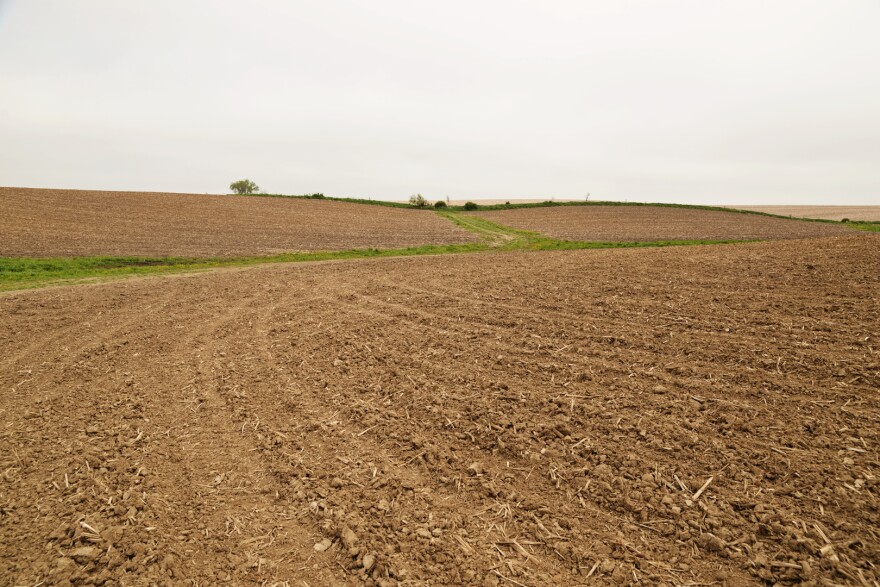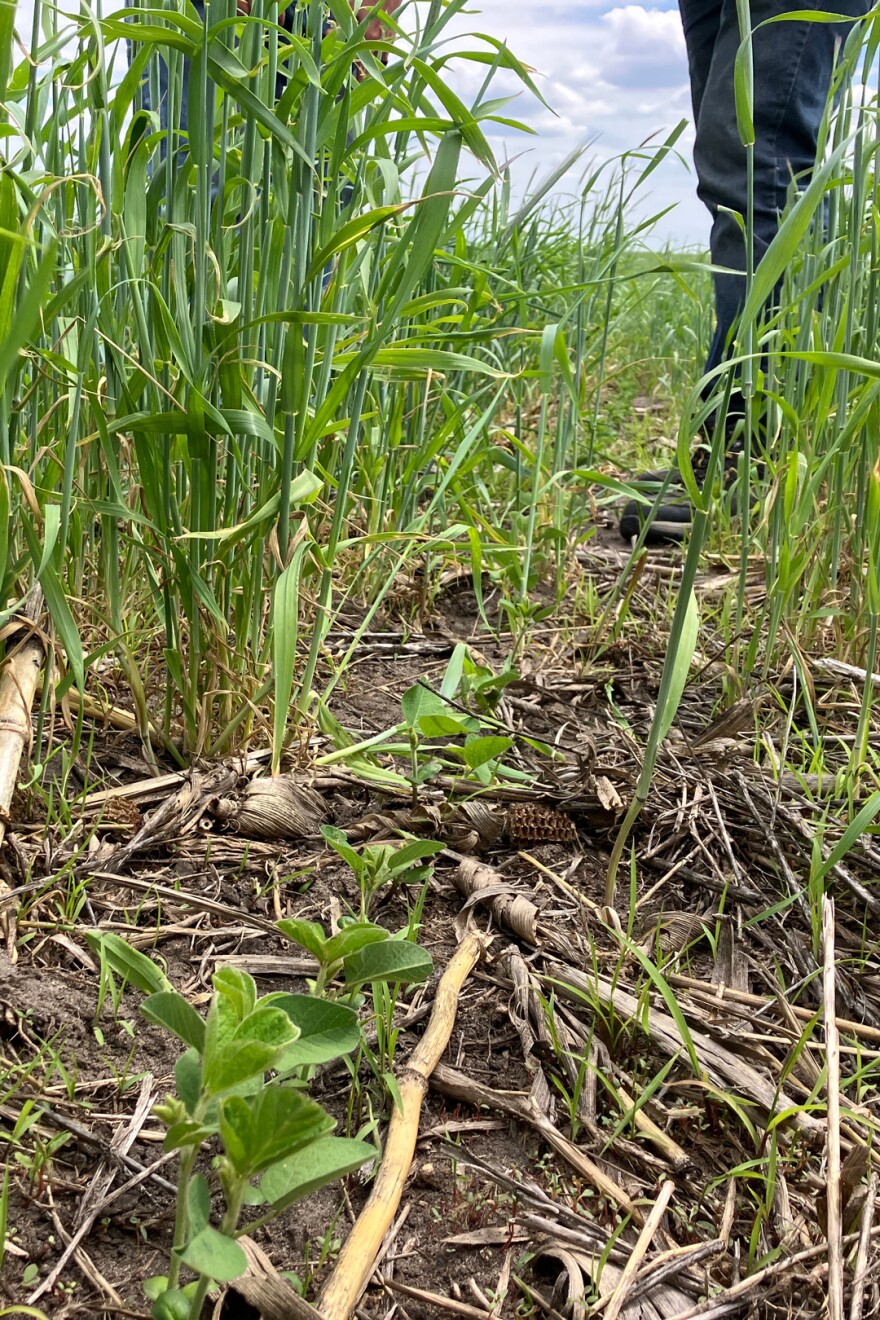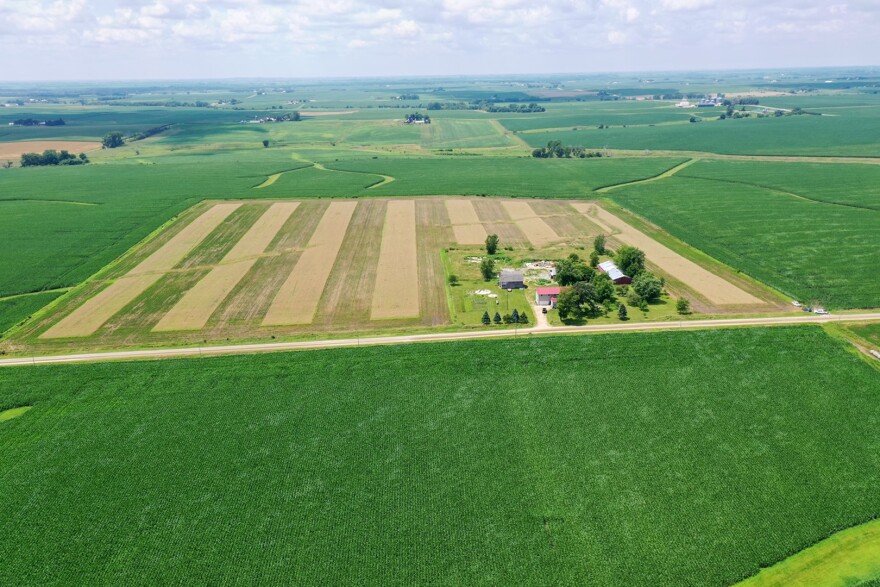On a farm in east central Iowa, pale green seed heads brush the shins of Mike Bretz as he walks through a field. He planted this cereal rye last October as part of a multi-year research project.
“Got a little bit of growth going in the fall and the winter there, and then of course, it starts coming up in the spring,” Bretz said.
He plans to harvest the rye in July. But it’s not the only crop growing in this field. Bretz leans down to inspect dark green leaves in tidy rows spaced 30 inches apart. He planted these soybeans mid-April and will harvest them in the fall.
Harvesting two crops with overlapping growing periods is called “relay intercropping.” It’s rare to see on farms in the U.S., but a group of farmers, researchers and policymakers say it could help reduce flooding in fields and downstream. Under the right market and weather conditions, this practice could also bump up farmers’ profit margins.

Heavier downpours
Over the last five decades, the average annual precipitation has in most of the Midwest. Rainfall events here and in other regions of the U.S. have become more intense, meaning heavier downpours in shorter periods of time.
“What used to come over two days happens in two hours. We're really seeing a demand on infrastructure that just can't keep up … pipes that are too small, natural systems that we've curtailed so they can't support and absorb all the water coming down,” said Melissa Roberts, founder and executive director of the American Flood Coalition.
The nonprofit works on policies at the local, state and federal level to help communities adapt to rising sea levels and more intense rainfall. Incorporating solutions now will pay off later, Roberts said.
Over the last decade, damage from flooding has averaged . The Congressional Budget Office predicts it could be by 2050 due to climate change.
“ the land in this country is agriculture and farmland,” Roberts said. “We cannot have solutions to flooding and disasters if we don't think about making that part of the solution, and think about empowering farmers to be part of the solution.”

The American Flood Coalition has supported a relay intercropping research project in Iowa, led by Northeast Iowa Resource Conservation and Development. The nonprofit’s work includes improving water quality and floodwater management in large watersheds.
“It’s easier to stop the raindrop where it falls, and that means improving the soil health and keeping the ground covered,” said Ross Evelsizer, a project director with Northeast Iowa RC&D.
A of farmers in the Corn Belt and Great Plains do this with cover crops. After harvesting corn or soybeans in the fall, they plant cereal rye, clover, oats or hairy vetch to topsoil from blowing or washing away.
Cover crops suppress weeds and absorb excess nitrogen and phosphorus, which can cause nutrient pollution downstream. They support earthworms, beneficial microbes and , and build organic matter in the soil, allowing it to absorb and release water like a sponge.
But this conservation practice has a few shortcomings, said Evelsizer.
The spring gap
kill their cover crops with herbicides in the early spring to plant their cash crop.
“And so right before we get the heaviest rains, which could create a flood event or when we’re most susceptible to lose nutrients, which is bad for water quality, we terminate that cover crop,” Evelsizer explained.
Relay intercropping keeps more roots in the soil year-round.
As part of a study with Northeast Iowa RC&D, researchers at Iowa State University and the Iowa Flood Center relay intercropping could increase infiltration, the rate by which water soaks into the soil, by up to 30%. They used this data and modeling software to scale up relay intercropping on crop acres in the Cedar Rapids Watershed to test its effects on flooding.
They found in Cedar Rapids, Iowa’s second largest city, could have been saved from monumental floods in and .

“As we’re going from these extreme weather conditions, from drought to flooding, [understanding] what’s going on under the surface really helps us with our flood forecasting but also with our drought forecasting,” said Kate Giannini, the program manager at the Iowa Flood Center.
The center is part of the University of Iowa College of Engineering and the only academic research center in the U.S. devoted solely to flooding.
“With climate change, [relay intercropping] is a new and innovative way to adapt to the intense rainfall events that we’re getting but also [in] managing drought risk,” said Kate Giannini, the program manager at the Iowa Flood Center.
Prolonged drought can exacerbate flooding, Giannini said. Dry, compacted soils have less capacity to absorb water, causing more runoff and erosion issues downhill.
Another shortcoming with cover crops is the initial cost, Evelsizer said.
“A lot of cover crop participation in Iowa and in the Midwest is predicated on incentive programs because it’s an added expense for producers,” Evelsizer said. “You have added seed costs, added trips across the field.”
In 2018, federal, state and private cost-share programs and incentives supported of the cover crop acres in the U.S. Evelsizer is hopeful that more farmers will keep year-round roots in the ground if there are market incentives.

Initial study results from 2018-2024 show farmers’ profits, on average, were $50.90 higher with relay intercropping per acre compared to a conventional soybean system. Even though relay intercropping caused a drag on soybean yields, Evelsizer said farmers came out ahead by selling two crops instead of one, alongside reduced input costs.
“We're not seeing land prices go down,” he said. “[Relay intercropping] provides the producer the opportunity to grow their acres vertically on the acres that they have, versus having to find new acres to grow additional crops.”
All in the timing
Relay intercropping is uncommon in the Midwest and mostly experimental, said Rob Myers, director of the University of Missouri Center for Regenerative Agriculture and Extension professor in the plant science and technology division.
But Myers said it could be a “viable option” for farmers.
“The challenge is how much are you impacting the yield to the soybeans?” Myers said. “The yield of the soybeans is going to be a little bit less by having the rye there in the field, overlapping for six to eight weeks.”
Myers said a farmer could still be profitable with a 5-10% reduction in soybean yields, because the sale of the cereal rye seed could more than make up for it.
“But if you’re cutting the soybean yield in half, like you might be during a dry year, then you’ve got a bigger problem,” Myers said.

Cereal rye and soybeans can compete for moisture during the six to eight week overlapping growth period, he said.
Evelsizer said that’s what happened in many of the field trials during the last two summers, which turned dry in July and August. He emphasized that “a really good rain or a couple of decent rains” after the rye harvest will fill out the soybean pods, but there’s room for improvement.
Farmers participating in the research project are continuing to test different soybean varieties, row spacing and the timing for planting and harvesting both crops to pinpoint best practices.
Insurance and markets
Crop insurance is another challenge with relay intercropping.
“You can still get crop insurance in that system, but you have to show some data that … relay intercropping won't hurt the soybean yield too much,” Myers said. “It’s a little bit of a gray area.”
Evelsizer said the USDA has accepted data from Northeast Iowa RC&D’s research trials, but it requires “quite a few hoops to jump through” and only insures the soybeans, not the cereal rye.
A lack of markets for cereal rye creates a third barrier to scale up relay intercropping.
“It's very easy to grow and market corn and soybeans in Iowa. There is infrastructure everywhere to support that,” Evelsizer said. “That doesn't exist for cereal grains.”
Many towns in Iowa and the Midwest have grain elevators that buy corn and soybeans. With cereal rye and other small grains, farmers often have to transport them longer distances to be milled, brewed or distilled. They also face higher quality standards for something that’s going to be consumed by people.
Evelsizer said farmers interested in relay intercropping should start small and save part of their cereal rye harvest to plant the following year. From there, they could sell it as cover crop seed to neighbors and scale up.
With acres of cover crops planted in the U.S. in 2022, Evelsizer said there’s a lot of potential.
Adapting the farm to more extreme weather
As clouds drifted above red barns and silos on Bretz's farm, he said the weather patterns today are different from what he experienced growing up.
“Hopefully, we can agree that whatever direction it goes — whether drier, wetter or just more inconsistent — that it’s going to be different,” Bretz said.
To adapt to more intense downpours and longer dry periods, Bretz started incorporating regenerative agriculture practices on his family’s 500 acres five years ago. He stopped tilling fields, planted cover crops and added small cereal grains into a three-year rotation with corn and soybeans.

“We’re trying to use nature to improve the water infiltration, so if we get 30 inches a year, we can hang onto that in the farm and not let that run off and then create contamination in the streams,” Bretz said.
He said the improvements to his soil are visible and measurable with ; he pounds a pipe into the ground and uses a stopwatch to record how long it takes for water to soak in.
Bretz added that his costs are dramatically lower with fewer fertilizers, herbicides and feed for his cattle, which graze on the cover crops in winter.
“I really think that there's an argument to be made for being more profitable by not having record [soybean and corn] yields,” he said.
Bretz saves some of his harvested cereal rye seed to plant in the fall and sells the rest to a local seed company. He’s also sold some of his cereal rye for special .
In his view, small cereal grains and diversity are part of the long-term viability of his family farm.
“At the end of the day, nature is not a monocrop. It's a variety of species, and those species tend to work together,” Bretz said.
This story was produced in partnership with , a collaboration of public media newsrooms in the Midwest. It reports on food systems, agriculture and rural issues.

